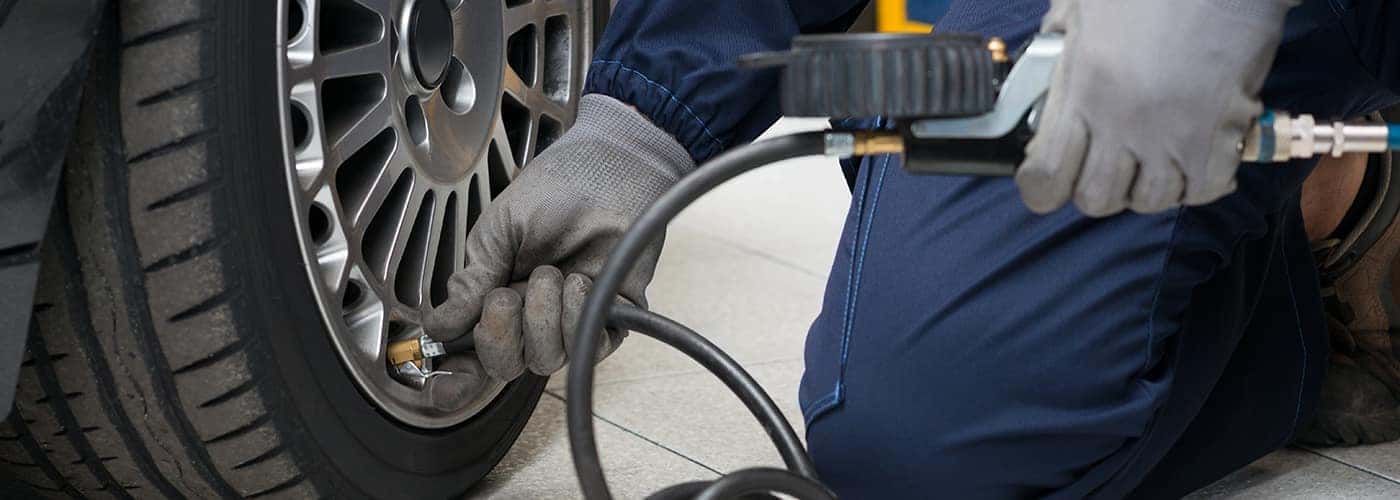Check your tire pressure once a month or before a long trip. Failure to do so can result in poor fuel economy, tire wear, and even accidents.
Maintaining proper tire pressure is crucial in ensuring safety and extending the life of your tires. Overinflated or underinflated tires can lead to increased fuel consumption, decreased handling, and tire blowouts, which can cause accidents. Therefore, it’s recommended to check your tire pressure at least once a month.
This also gives you ample time to fix any issues before they become a problem on the road. Additionally, it’s important to check your tire pressure before any long trip to ensure maximum safety while driving. Keep in mind that different factors such as tire types, vehicle weight, and weather conditions can affect tire pressure, so it’s essential to regularly monitor and adjust as needed.

Credit: www.landroverparamus.com
How Often To Perform Tire Pressure Checks
When it comes to ensuring optimal tire performance, one of the most important factors is maintaining proper tire pressure. In this section, we will explore the frequency with which tire pressure checks should be conducted, taking into account factors such as vehicle type, climate, and tire repairs or replacements.
Manufacturer’S Recommendations
While there is no hard and fast rule on how often to perform tire pressure checks, each vehicle’s manufacturer usually provides a guideline in the owner’s manual. Typically, it is recommended that tire pressure is checked at least once a month, preferably before driving when the tires are cool.
It is also advised to check and adjust the tire pressure before long trips or when carrying heavy loads.
Frequency For Different Types Of Vehicles
Different types of vehicles may require different tire pressure checks frequency.
- Cars: Once a month or before long trips or when carrying heavy loads
- Trucks: At least once a month, or more frequently if carrying heavy loads or driving off-road
- Suvs: At least once a month, or more frequently if driving on rough terrains or carrying heavy loads
Climate Considerations
Tire pressure can be affected by temperature changes, so it is especially important to conduct regular checks in areas with extreme temperature variations.
- Hot climate: Every two weeks or before long trips
- Cold climate: Once a week or before long trips
When To Check After Tire Repairs Or Replacements
Tire repairs or replacements can lead to changes in tire pressure, which can affect the tires’ performance. Thus, it is important to check and adjust tire pressure after any tire repair or replacement. Furthermore, it is recommended to keep checking the tire pressure regularly for the next month to ensure that everything is stable.
Regular tire pressure checks are essential for ensuring optimal tire performance and prolonging the tires’ lifespan. By following the aforementioned guidelines, you can keep your tires at the appropriate pressure level and enjoy a smooth, safe ride.
Signs That Tire Pressure Needs To Be Checked
Maintaining the correct tire pressure is key to keeping your vehicle safe and running smoothly.
Warning Lights
Modern vehicles have a built-in warning system that alerts you when your tire pressure is too low. If you see a warning light on your dashboard, it’s important to check the pressure of your tires as soon as possible. Ignoring the warning light could result in a decrease in fuel efficiency, uneven tire wear, and even an increased risk of a blowout.
Handling Issues (E.G. Pull To One Side, Vibrating)
If you notice that your vehicle is pulling to one side or that your steering wheel is vibrating, it may be a sign that your tire pressure is too low. This is because unbalanced tire pressure can affect the handling of your vehicle, leading to steering issues.
Checking the pressure of your tires can help remedy these issues and make sure your vehicle is running smoothly.
Changes In Tire Appearance (E.G. Bulges, Cracks)
A final sign that it may be time to check your tire pressure is any changes in the appearance of your tires. Bulges or cracks in the sidewall of your tire can be a sign that your tire pressure is too low or that there is an issue with your tire’s structure.
Checking the pressure of your tires regularly can help prevent any potential safety hazards.
Remember that it’s important to check your tire pressure regularly – at least once a month – to ensure your vehicle is roadworthy and running smoothly. By checking your tire pressure consistently, you can prevent any potential issues and save yourself time and money in the long run.
Equipment Needed For Checking Tire Pressure
When it comes to driving, checking tire pressure is a crucial aspect that every vehicle owner should prioritize. Not only does it optimize the vehicle’s performance, but it also ensures a safe driving experience. However, before checking tire pressure, you must have the right tools on hand to get an accurate reading.
We will discuss the equipment needed for checking tire pressure.
Types Of Tire Pressure Gauges
There are different types of tire pressure gauges available, so it’s essential to choose the right one according to your preference.
- Digital tire pressure gauge: Digital gauges are easy to read and offer quick readings. It’s best for those who want a quick and straightforward way to check their tire pressure.
- Dial tire pressure gauge: Dial gauges are more accurate than digital gauges, but they need to be calibrated frequently to provide reliable readings.
- Pencil tire pressure gauge: Pencil gauges are cheap and easy to use, but they are not as accurate as the other two types.
Other Tools To Keep On Hand
Apart from a tire pressure gauge, there are a few other essential tools that you should keep on hand to ensure that you get an accurate reading.
- Valve caps: Valve caps keep the valve clean and prevent air from escaping.
- Tire inflator: A tire inflator comes in handy when you need to inflate your tires.
- Tire tread depth gauge: This tool is used to measure tire tread depth, which allows you to determine if your tires need replacing.
Tips For Accurate Readings
Using the right equipment is only half the battle when it comes to checking tire pressure.
- Always check the tire pressure when the tires are cold, before driving.
- Make sure the tire gauge is securely attached to the valve stem.
- Take two or three readings and use the average for the final tire pressure.
- Check the tire pressure at least once a month, and before taking a long trip.
Checking the tire pressure is a fundamental aspect of the vehicle’s maintenance routine. By having the right equipment and following the tips mentioned above, you can ensure that you get an accurate reading and maintain a safe driving experience.
Steps To Check Tire Pressure
When it comes to tire maintenance, checking tire pressure is crucial for not only prolonging the lifespan of your vehicle’s tires but also keeping you safe on the road. It’s important to check tire pressure every month or before a long road trip.
In this post, we’ll go over the steps to check tire pressure properly.
Prepping The Tires For Testing
Before you begin testing tire pressure, you’ll need to do a few things to prep the tires:
- Make sure the tires are cool to the touch. Tires heat up as you drive, so it’s best to wait at least 3 hours after driving to check the tire pressure for accuracy.
- Remove the valve cap and keep it in a safe place.
Testing Tire Pressure
Now that your tires are prepped, it’s time to test tire pressure:
- Attach the tire pressure gauge to the valve stem and press down firmly until the gauge reads the pressure.
- If you hear a hissing sound, that means air is escaping and you need to press down again to get an accurate measurement.
- Repeat this process for all four tires.
Understanding The Correct Psi For Your Vehicle
Each vehicle has a specific recommended psi range for its tires. It’s important to know the correct psi range for your vehicle to avoid under-inflation or over-inflation. You can find the recommended psi range in your vehicle’s owner manual or on the sticker inside the driver side door.
Adding Air If Necessary
If you’ve determined that your tire pressure is too low, you’ll need to add air.
- Loosen the valve cap and attach the air pump hose to the valve.
- Add air in short bursts while checking the tire pressure with the gauge until you reach the recommended psi range. It’s important not to over-inflate the tire.
- Tighten the valve cap and recheck the pressure to ensure accuracy.
Re-Testing And Adjusting As Needed
After adding air, it’s important to retest and check tire pressure again to ensure it’s within the recommended psi range. Check each tire before and after adding air as needed.
Checking tire pressure may seem like an inconvenience, but it’s an important part of tire maintenance that can save you from costly repairs and keep you safe on the road. By following these steps every month or before a long road trip, you can prolong the life of your tires and ensure a smooth ride.
Frequently Asked Questions On When To Check Tire Pressure
When Should I Check My Tire Pressure?
You should check your tire pressure at least once a month and before long trips. It’s best to check it when the tires are cold.
How Do I Know If My Tires Need Air?
If your tires look a bit flatter than usual or your car is handling poorly, you may need to add air. Check your owner’s manual for recommended pressure.
What Happens If My Tire Pressure Is Too Low?
Low tire pressure can cause poor fuel economy, uneven tire wear, poor handling, and even tire failure. It’s important to maintain proper tire pressure.
How Much Air Should I Put In My Tires?
Check your car’s manual or the sticker on the driver’s side doorjamb for the recommended tire pressure. Never exceed the maximum pressure listed on the tire.
Can Tire Pressure Affect My Car’S Performance?
Yes, tire pressure can significantly affect your car’s performance and handling. Properly inflated tires can improve fuel economy, handling, and overall safety.
Can I Check My Tire Pressure Myself?
Yes, you can check your tire pressure yourself with a tire pressure gauge. They’re available at most auto parts stores and are easy to use.
Conclusion
Proper checking of tire pressure is vital for your safety and to ensure your vehicle runs smoothly. It is recommended to check the tire pressure monthly or before long trips. It is also important to check the pressure when the temperature fluctuates as it can significantly impact tire pressure.
Don’t forget to check the spare tire as well. Underinflated tires can lead to decreased fuel efficiency, premature wear and tear, and increase the risk of tire blowouts and accidents. Prevention is better than cure, so make a habit of checking tire pressure regularly.
In case of any doubts, consult the owner’s manual or a professional mechanic for guidance. Taking a few minutes to check and maintain the tire pressure can save you time, money, and keep you safe on the road. Don’t neglect the importance of tire pressure and make it a priority to check it regularly.
